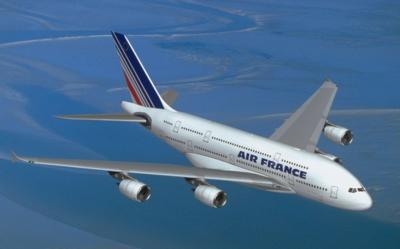Wed, Mar 14, 2012
AIRE Trials Supported By Airbus
Three Airbus-supported projects in the Atlantic Interoperability Initiative to Reduce Emissions (AIRE) have demonstrated how improved ground operations and air traffic management procedures can contribute to reductions in fuel consumption for the air transport industry. One element in this second wave of European AIRE flight trials were the Transatlantic Green Flights, using Air France’s A380 in service between New York and Paris. The focus was on performing two-engine taxi-out procedures for the ground movement phase, and optimising the transatlantic trajectory for the en-route flight phase.

Airbus led the A380 Transatlantic Green Flights activity, working in partnership with Air France and the air navigation service providers from the UK, Canada and the United States. A total of 17 successful trials were achieved, and the predicted combined fuel gain potential of approximately one ton per transatlantic crossing was confirmed.
Another project was Green Shuttle, performed under the French air navigation service provider’s leadership, with Air France and Airbus as partners. By optimizing the lateral and vertical trajectories during all phases of regularly-scheduled shuttle services between Paris’ Orly Airport and Toulouse in southwestern France, it demonstrated improved fuel efficiency through 60 revenue flights.
The Green Shuttle operations were made possible through better coordination among the five involved French air traffic control centers, with 154 lbs. of fuel saved per flight from Orly to Toulouse, and 440 lbs. per flight in the opposite direction. In its contribution, Airbus performed flyability analyses for the Continuous Descent Approach (CDA) into Toulouse and provided recommendations for the optimization of this procedure.
The third element – called the VINGA project – involved the validation of Required Navigation Performance (RNP) arrival procedures with the A320. The Airbus Quovadis subsidiary – which offers services for the implementation of RNP procedures – contributed to the VINGA project, under leadership of the Swedish air navigation service provider, with Novair and Gothenborg Airport as additional partners. VINGA optimized all phases of flight, with an emphasis on the implementation of new RNP arrival procedures. A fuel gain of 48-200 lbs. per segment was measured in the latter phase of over 100 trial flights.
Results of the VINGA project, along with the Transatlantic Green Flights and Green Shuttle, were presented at this month’s Air Traffic Control Global 2012 Conference and Exhibition in Amsterdam. (Image provided by Airbus)
More News
Terminal Radar Service Area Airspace surrounding designated airports wherein ATC provides radar vectoring, sequencing, and separation on a full-time basis for all IFR and participa>[...]
Aero Linx: Utah Back Country Pilots Association (UBCP) Through the sharing experiences, the UBCP has built upon a foundation of safe operating practices in some of the most challen>[...]
From 2010 (YouTube Edition): Imagine... Be The Change... Inspire FROM 2010: One of the more unusual phone calls I have ever received occurred a few years ago... from Anousheh Ansar>[...]
(Pilot) Felt A Shudder And Heard The Engine Sounding Differently, Followed By The Engine Chip Detector Light On April 14, 2025, about 1800 Pacific daylight time, a Bell 206B, N1667>[...]
Also: AMA Names Tyler Dobbs, More Falcon 9 Ops, Firefly Launch Unsuccessful, Autonomous F-16s The Air Force has begun ground testing a future uncrewed jet design in a milestone tow>[...]
 ANN's Daily Aero-Term (05.07.25): Terminal Radar Service Area
ANN's Daily Aero-Term (05.07.25): Terminal Radar Service Area ANN's Daily Aero-Linx (05.07.25)
ANN's Daily Aero-Linx (05.07.25) Classic Aero-TV: Anousheh Ansari -- The Woman Behind The Prize
Classic Aero-TV: Anousheh Ansari -- The Woman Behind The Prize NTSB Prelim: Bell 206B
NTSB Prelim: Bell 206B Airborne-NextGen 05.06.25: AF Uncrewed Fighters, Drones v Planes, Joby Crew Test
Airborne-NextGen 05.06.25: AF Uncrewed Fighters, Drones v Planes, Joby Crew Test



